Animal
| I | INTRODUCTION |
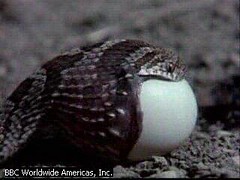
Swallowing Snake
BBC Worldwide Americas, Inc.
Animal, multicellular organism that obtains energy by eating food. With over 2 million known species, and many more awaiting identification, animals are the most diverse forms of life on earth. They range in size from 30-m (100-ft) long whales to microscopic organisms only 0.05 mm (0.002 in) long. They live in a vast range of habitats, from deserts and Arctic tundra to the deep-sea floor. Animals are the only living things that have evolved nervous systems and sense organs that monitor their surroundings. They are also the only forms of life that show flexible patterns of behavior that can be shaped by past experience. The study of animals is known as zoology.
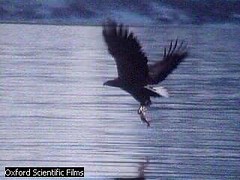
Fierce Hunter
A flying eagle snatches a fish from the water with its long, curved talons. It will carry the fish to a feeding place on land before devouring it. Eagles hunt only during the day; by night, they perch safely in their nests or in some other high spot.
Oxford Scientific Films
Most animals start life as a single fertilized cell, which divides many times to produce the thousands or millions of cells needed to form a functioning body. During this process, groups of cells develop different characteristics and arrange themselves in tissues that carry out specialized functions. Epithelial tissue covers the body’s inner and outer surfaces, while connective tissue binds it together and provides support. Nervous tissue conducts the signals that coordinate the body (see Nervous System), and muscle tissue–which makes up over two-thirds of the body mass of some animals–contracts to make the body move. This mobility, coupled with rapid responses to opportunities and hazards, is one feature that distinguishes animals from other forms of life.
Some kinds of animal movement, such as the slow progress of a limpet as it creeps across rocks, are so slow that they are almost imperceptible. Others, such as the attacking dive of a peregrine falcon or the leap of a flea, are so fast that they are difficult or even impossible to follow. Many single-celled organisms can move, but in absolute terms, animals are by far the fastest-moving living things on earth.
Animal life spans vary from less than 3 weeks in some insects to over a century in giant tortoises. Some animals, such as sponges, mollusks, fish, and snakes, show indeterminate growth, which means that they continue to grow throughout life. Most, however, reach a pre-defined size at maturity, at which point their physical growth stops.
| II | TYPES OF ANIMALS |
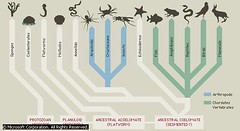
Animal Kingdom
Kingdom Animalia includes more than one million living species, grouped into more than 30 phyla. Vertebrates, members of the phylum Chordata, comprise only one percent of these organisms. Phylum Arthropoda is more successful in sheer numbers, total mass, and distribution than all other groups of animals combined. The remaining animal phyla are composed of mostly marine-dwelling organisms. Illustrated here is the evolutionary relationship between all of these groups.
© Microsoft Corporation. All Rights Reserved.

Body Plans of Animals
The basic body plan of an animal, shown here in cross section, is one of the characteristics used to classify animals into separate phyla. Cnidarians such as jellyfishes and sea anemones have two layers of tissue, endoderm and ectoderm, surrounding a digestive cavity. In some animals a third layer, mesoderm, develops between the endoderm and ectoderm. Among these, flatworms and ribbon worms are called acoelomates, because they lack a separate body cavity, or coelom. Nematodes have an extra, epithelial-lined cavity called a pseudocoelom, but only animals such as annelids and chordates have a true coelom, a fluid-filled chamber situated actually within the mesoderm.
© Microsoft Corporation. All Rights Reserved.
Presently, animals are classified according to a broader range of characteristics, including their internal anatomy, patterns of development, and genetic makeup. These features provide a much more reliable guide to an animal’s place in the living world. They also help to show how different species are linked through evolution. Scientists divide the animal kingdom into approximately 30 groups, each called a phylum (plural phyla).
| A | Vertebrates and Invertebrates |

Vertebrate Embryos
Vertebrates that evolved from fish pass through similar embryonic stages. As a flexible notochord develops in the back, blocks of tissue called somites form along each side of it. These somites will become major structures, such as muscle, vertebrae, connective tissue, and, later, the larger glands of the body. Just above the notochord lies a hollow nerve cord. Such similarities formed the basis for German biologist Ernst Haeckel’s biogenetic law, which states that an animal’s embryonic development recapitulates its evolution. Although scientists now know that this law does not hold absolutely, Haeckel’s idea has remained influential.
© Microsoft Corporation. All Rights Reserved.
One phylum of animals, the chordates, has been more intensively studied than has any other, because it comprises nearly all the world’s largest and most familiar animals as well as humans. This phylum includes mammals, birds, reptiles, amphibians, and fish together with a collection of lesser-known organisms, such as sea squirts and their relatives (see Tunicates). The feature uniting these animals is that at some stage in their lives, all have a flexible supporting rod, called a notochord, running the length of their bodies. In the great majority of chordates, the notochord is replaced by a series of interlocking bones called vertebrae during early development. These bones form the backbone, and they give these animals their name—the vertebrates.
Vertebrates total about 40,000 species. Thanks to their highly developed nervous systems and internal skeletons, they have become very successful on land, sea, and air. Yet vertebrates account for only about 2 percent of animal species. The remaining 98 percent, collectively called invertebrates, are far more numerous and diverse and include an immense variety of animals from sponges, worms, and jellyfish to mollusks and insects. The only feature these diverse creatures share in common is the lack of a backbone.
Some invertebrate phyla contain relatively few species. An extreme example is the phylum Placozoa, which contains just one species. Measuring less than 0.5 mm (0.02 in) across, this unique animal was first discovered in 1883 in a saltwater aquarium in Austria. Its flat body consists of just two layers of cells, making it the simplest known member of the animal kingdom, although not the smallest. Another minor phylum, the loriciferans, was classified in 1983 with the chance discovery of a tiny organism dredged up in marine gravel. Several other species of loriciferans have since been identified, but little is known about how they live.
At the other end of the spectrum, some invertebrate phyla contain immense numbers of species. These major phyla include the annelids (segmented worms), with 12,000 known species; the nematodes (roundworms), also with 12,000 known species; and the mollusks, including bivalves, snails, and octopuses, with at least 100,000 species. The arthropods, with about 1 million known species, include the insects, spiders, and crustaceans. These figures include only species that have been described and named, which are only a portion of those that actually exist. Some biologists estimate that the total number of nematode species may be as high as a quarter of a million, while the total number of arthropods could exceed 10 million.
Compared to vertebrates, most invertebrates are animals of modest dimensions. Giant squids, which are the largest invertebrates, can exceed 18 m (60 ft) in length, but the great majority of invertebrate animals are less than 2.5 cm (1 in) long. Their small size enables them to exploit food sources and infiltrate habitats that larger animals cannot use, but it also leaves them exposed to changing environmental conditions. This is not often a problem in the sea, but it can create difficulties on land. Land-dwelling invertebrates have to cope with the constant threat of drying out, and most of them quickly become inactive in low temperatures.
| B | Cold-blooded and Warm-blooded Animals |
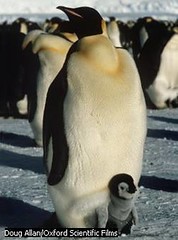
Penguin Keeping Its Young Warm
Penguins always return to their ancestral nesting sites to lay their eggs and rear their young. The emperor penguin, the largest of the penguins, lays its single egg during the coldest time of the Antarctic year, when temperatures drop as low as -62 degrees C (-80 degrees F). The egg is incubated on top of the parent’s feet, protected by abdominal folds of skin. Young chicks remain under these abdominal folds until they are able to regulate their own body temperature.
Doug Allan/Oxford Scientific Films
On land, some invertebrates manage to overcome the problem of cold by using muscles to warm themselves. For example, many large moths and bumblebees use a special form of shivering to raise their body temperature to 35°C (95°F) before they take off, which allows them to fly in cool weather. Bees also maintain warm conditions in their nests, which speeds up the development of their young. But in invertebrates as a whole, temperature regulation is very unusual. In vertebrates, on the other hand, it has developed to a high degree.
Vertebrates are customarily divided into cold-blooded and warm-blooded animals, but these labels are not very precise. Biologists normally use the terms ectoderm and endoderm to describe temperature regulation more accurately. An ectoderm is an animal whose temperature is dictated by its surroundings, while an endoderm is one that keeps its body at a constant warm temperature by generating internal heat.
Reptiles, amphibians, and fish are ectoderms. Although they do not maintain a constant warm temperature, some of these animals do manage to raise their body temperature far above that of their surroundings. They do this by behavioral means, such as basking in direct sunshine when the surrounding air is cool. Mammals and birds are endoderms. These animals generate heat through their metabolic processes, and they retain it by having insulating layers of fat, fur, or feathers. Because their bodies are always warm, they can remain active in some of the coldest conditions on earth.
| III | ANIMAL HABITATS |
Few parts of Earth’s surface are entirely devoid of animal life. Animals cannot survive in places where water is unavailable or permanently frozen, or where temperatures regularly exceed 55° C (130° F). However, in all habitats that lie between these extremes, animal life abounds.
| A | Aquatic Habitats |

Tidal Pool
The fluctuation of the tide allows for a unique environment along shorelines. The current continually circulates and replenishes a rich supply of nutrients along beaches, but organisms living there must be adapted to both buffeting waves and frequent shifts from open air to complete submersion. Marine organisms adapt to the constantly changing surroundings in a variety of ways. Starfish use suction-cup feet, barnacles fix permanently to large objects like rocks and boats, and seaweed anchors firmly to the ocean floor. When the tide goes out, pockets of water remain trapped in rocks, depressions in the sand, and natural basins called tidal pools, like the one shown here during low tide.
Pat O'Hara Photography
Animal life first arose in water. Millions of years later, marine and freshwater habitats continue to support a large proportion of the animal life on earth. Aquatic habitats—particularly in the seas and oceans–rarely experience abrupt changes in conditions, which is a major advantage for living things.
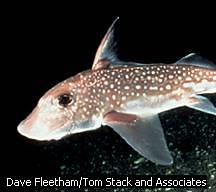
Ratfish
The ratfish is a member of a species of deep-water fish related to sharks. The deep-water habitat of the ratfish is dark, cold, and vast. Like many deep-water predators, the ratfish uses several senses to track prey; its eyes are used to located bioluminescent prey The poisonous spine in front of the dorsal fin is used defensively.
Dave Fleetham/Tom Stack and Associates
On reefs and rocky shores, many animals are sessile, meaning that they spend their entire adult lives fixed in one place. These species, which include sponges, barnacles, and mollusks, as well as reef-building corals themselves, typically spend the early part of their lives as drifting larvae, before settling on a solid surface and changing shape. Sessile animals are common in aquatic habitats because it is relatively easy for them to collect food, which typically is pushed in the animal’s direction by water currents. By contrast, very few sessile animals have evolved on land.
In open water, depth has a marked influence on animal lifestyles. The surface layers of the open sea teem with small and submicroscopic animals, which feed either on algae and other plantlike organisms or on each other. These animals form part of the plankton, a complex community of living things that drifts passively with the currents. Many planktonic animals can adjust the depth at which they float, but larger animals such as fish, squid, and marine mammals, are strong enough to commute between the surface and the depths far below.
Even in the clearest water, light quickly fades with increasing depth. Deeper than about 150 m (500 ft), not enough light penetrates for photosynthesis to occur, so algae are unable to survive. With increasing depth, water pressure rises and temperature falls, ultimately coming close to the freezing point on the ocean floor. Despite these extreme conditions, animal life is found in the ocean’s greatest depths, fueled by the constant rain of organic debris that drifts down from far above. In a habitat where prey is widely scattered, many deep-sea fish can swallow animals larger than themselves, an adaptation that allows them to go weeks or months between meals.
| B | Land Habitats |

Zoogeographic Regions
The world’s land area is divided into six zoogeographic regions, each with different fauna. Within these regions, animals are grouped by the particular habitat they occupy. Land animals will tend toward habitats based on many factors, including indigenous food and availability of natural protection from predators.
© Microsoft Corporation. All Rights Reserved.
On land, animal habitats are strongly influenced by climate, the combination of precipitation and temperature conditions experienced in a region. At or near the equator, year-round moisture and warmth generates a constant supply of food. Further north or south, seasonal changes become much more pronounced, shaping the type of animals that live in different habitats and their strategies for survival (see Animal Distribution).
Tropical and subtropical forests are home to by far the largest number of animal species on land. These animals include the majority of the world’s insects, most of its primates, and a large proportion of its birds. Tropical forests have existed longer than any other forests on earth and their plants and animals have evolved an elaborate web of interrelationships.
Much of the animal life of tropical forests is still poorly known, and new species are constantly being discovered. The majority of these newly identified animals are invertebrates, but larger animals have also come to light during the 20th century. Major discoveries have included three large but secretive plant-eating mammals: the okapi, discovered in Central Africa in 1900; the kouprey, discovered in the forests of Cambodia in 1937; and the sao la, which was identified in forests bordering Laos and Vietnam in 1993.
Unlike tropical forests, temperate forests provide animals with an abundance of food during spring and summer, but a dearth during the winter. In this habitat, animals have evolved several different strategies for avoiding starvation during the winter months. Food hoarders, such as squirrels and jay birds, bury surplus food during the fall, and dig it up again when other food supplies run out. Other forest animals, such as the common dormouse, avoid food shortages by hibernation, a period of inactivity when body temperature is lowered. A third group of animals—composed chiefly of birds, but also including some bats and insects–migrates to warmer regions before the winter begins and returns again in spring. In boreal forests, which are found in the far north, the seasonal swings are more extreme. Here only a few species stay and remain active during the winter months.
For land animals, the most testing habitats are ones that experience intense drought or extreme cold. Desert animals cope with heat and water shortage by behavioral adaptations, such as remaining below ground by day, and also by physiological adaptations. North American kangaroo rats, for example, can live entirely on dry seeds without ever drinking liquid water. They do this by losing very little moisture from their bodies and using all the “metabolic water” that is formed when food is broken down to release energy.
In tundra and on polar ice, winter air temperatures can fall to below -40° C (-40° F), which is far colder than the temperature of the surrounding seas. The smallest inhabitants of tundra, which include vast numbers of mosquitoes and other biting flies, spend winter in a state of suspended animation and are kept alive by chemical antifreeze within their tissues. The few animals that do remain active on land or ice during winter, such as seals and male emperor penguins, rely on a thick layer of insulating fat to prevent their body heat leaking away. Without this fat, they would die within a matter of minutes.
| IV | FEEDING |
Animals all feed on organic matter, but their diets and way of obtaining food vary enormously. Some animals are omnivores, meaning that they are capable of surviving on a very wide range of foods. Many other animals, from giant pandas to fleas, have extremely precise requirements and cannot deviate from their highly specialized diet.
| A | Herbivores and Carnivores |
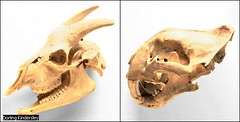
Meat Eaters and Plant Eaters
In carnivores (right), the front of the skull has a pair of enlarged canine teeth and the lower jaw moves only in an up and down direction, which assists with the capture and holding of prey. In herbivores (left), the canine teeth are absent and the premolars and molars are well developed. The jaw construction also allows for the lateral movement of the lower jaw in relation to the upper jaw, which helps to provide a grinding motion necessary for rendering plant materials into a state suitable for swallowing and digestion.
Dorling Kindersley
In general, animals eat plants, other animals, or the remains of living things. Plant-eaters, or herbivores, often do not have to search far to find things to eat, and in some cases—for example wood-boring insects—they are entirely surrounded by their food. The disadvantage of a plant-based diet is that it can be difficult to digest and is often low in nutrients.

Alligator Snapping Turtle
The alligator snapping turtle, the largest of the freshwater turtles, has a ridged, camouflaged shell and powerful jaws. When a fish, mistaking a small, wriggling projection on the turtle’s tongue for a worm, swims within reach, the turtle captures it by quickly snapping its jaws shut.
Dorling Kindersley
Carnivores live on flesh from other animals that is often nutrient-rich and easy to digest but difficult to obtain. Finding and capturing this kind of food calls for keen senses. But even though a hunter has acute vision or a highly developed sense of smell, a large proportion of a hunter’s victims manage to escape. If this happens too often, a predator quickly starves.
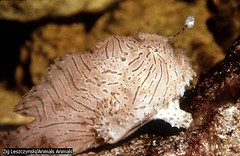
Anglerfish
Anglerfish have appendages that serve as fishing rods or lures to attract prey, mainly other fish. They are found in oceans all over the world and generally inhabit deep waters. Certain species can grow to lengths of about 1.5 m (5 ft), and have huge mouths capable of swallowing fish of equal size.
Zig Leszczynski/Animals Animals
In this method of hunting, camouflage and other forms of deception play a prominent role. Most animals that use a lie-and-wait strategy blend in with their surroundings, but a few use lures to entice their prey within range. A typical example is the alligator snapping turtle of North America, which waves a ribbon of pink flesh on its tongue that resembles a worm. Any fish venturing toward it is swallowed whole.
In predatory animals, teeth or other mouthparts often play a part in catching and subduing food as well as in preparing it for digestion. These mouthparts include canine teeth in carnivorous mammals, venomous fangs in snakes, and poisonous “harpoons” in some marine mollusks. These harpoons can impale and kill small fish. Each harpoon is used just once, and afterwards it is expelled and another is formed in its place.
| B | Other Feeding Strategies |
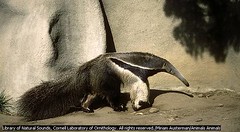
Giant Anteater
Anteaters are native to Central and South America, inhabiting both forest and open-plain regions. The giant anteater, shown here, is the largest of the species, weighing up to 23 kg (50 lb). The animal is well-adapted to hunt for insects, its sole source of food, because of its long front claws and sticky tongue, which can extend to 60 cm (24 in).
Library of Natural Sounds, Cornell Laboratory of Ornithology. All rights reserved./Miriam Austerman/Animals Animals
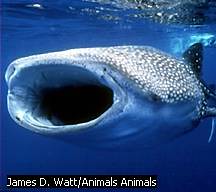
Whale Shark
Strictly a filter feeder, the whale shark strains plankton and small fish from the upper waters of tropical and subtropical seas by lying motionless beneath the water’s surface. Considered the largest living species of fish, a whale shark may measure more than 15 m (50 ft) in length and weigh more than 18 metric tons. The whale shark poses little risk to humans; however, whale sharks have been known to ram boats that they have mistaken for rival sharks.
James D. Watt/Animals Animals

Female Mosquito Sucking Blood
There are approximately 2,000 species of mosquitoes ranging from the tropics to the Arctic Circle and from sea level to mountaintops. All mosquitoes belong to the insect order Diptera, which includes all of the flies, or two-winged insects. All species of Dipterans have a single pair of wings for flying and a second vestigial pair called halteres, which act as organs of balance. Female mosquitoes have hypodermic mouthparts which enable them to pierce the skin and suck the blood of mammals, birds, reptiles, and other arthropods. The males have reduced mouthparts and feed instead on nectar and water.
Tim Shepherd/Oxford Scientific Films

Life Cycle of Human Blood Flukes
Flukes of the genus Schistosoma parasitize two hosts. The young hatch from their eggs in rivers and lakes and enter a specific kind of aquatic snail, where they develop into tadpole-like larvae called cercariae. When the cercariae leave the snail, they burrow through the skin of a human host swimming or wading in infested water. Adult flukes mature in the host’s bloodstream and settle in the veins of the gut. Their eggs, deposited in the lining of the human intestine and bladder, pass back into water via the sewage system, and the cycle begins again. More than 200 million people worldwide suffer from schistosomiasis, a disease characterized by the abscesses and bleeding caused by the flukes’ infestation.
© Microsoft Corporation. All Rights Reserved.
To avoid the need to track down food, some animals use a highly specialized feeding strategy, called parasitism (see Parasite). A parasite lives on or inside other animals and simply siphons off some of its host’s food or, more commonly, feeds on the host itself. External parasites, such as fleas, have well-developed senses and adaptations that enable them to cling to their hosts. Internal parasites, such as tapeworms and liver flukes, are highly modified for a life inside their hosts. The sense organs of internal parasites are rudimentary or absent because they do not need to find food or avoid enemies. Instead, they devote their time entirely to the twin tasks of feeding and reproduction.
| V | BREATHING |
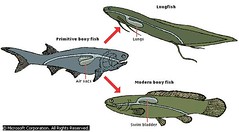
Evolution of Air-Breathing Organisms
Both the lung structure of air-breathing organisms and the swim bladders of most modern fishes evolved from paired air sacs of primitive bony fishes. In the primitive fish, as in the modern bony fishes, these sacs served as a buoyancy device that inflated and deflated to alter the fish’s depth in the water. In other fish, they became primitive lung structures, repeatedly folding inward to maximize oxygen uptake in an oxygen-deprived environment. Both kinds of fishes improved upon a preexisting adaptation but in so doing evolved into very different groups of organisms.
© Microsoft Corporation. All Rights Reserved.

How Fish Breathe
A fish breathes by absorbing oxygen from the water it drinks. Water flows into the mouth, through the gills, and out of the body through gill slits. As water flows through the gills, the oxygen it contains passes into blood circulating through gill structures called filaments and lamellae. At the same time, carbon dioxide in the fish’s bloodstream passes into the water and is carried out of the body.
© Microsoft Corporation. All Rights Reserved.

Axolotl Showing External Gills
The axolotl is actually the aquatic larval stage of the brown salamander. Axolotls are of interest to scientists because not all axolotls metamorphose, or change, into adult salamanders. More interestingly, those axolotls that do not transform may become sexually mature while in the larval stage. In captivity, axolotls can be induced to change into adult salamanders by the addition of thyroid extract to the surrounding water.
G.I. Bernard/Oxford Scientific Films
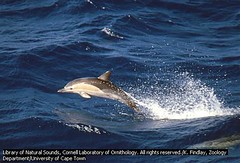
Dolphin Surfacing for Air
A Pacific whitesided dolphin breaks the surface of the water while swimming to breathe through a blowhole on the top of its head. Underwater, a dolphin communicates with whistles emitted in single-toned squeals to convey alarm, sexual excitement, and perhaps other emotional states. Dolphins inhabit all the world’s oceans, using their streamlined bodies to reach underwater speeds of 40 km/h (25 mph). This swimming ability coupled with sharp teeth enables dolphins to capture fish and squid, their principal prey.
Library of Natural Sounds, Cornell Laboratory of Ornithology. All rights reserved./K. Findlay, Zoology Department/University of Cape Town
In tracheae and most lungs, gases move in a two-way flow. Most vertebrates actively pump air in and out of their lungs to step up the rate of gas exchange. By stretching and squeezing their bodies, some arthropods behave in a similar way.
| VI | MOVEMENT |
All animals can move parts of their bodies. The majority are also capable of locomotion—movement of the whole body from place to place. Many simple animals, such as rotifers and flatworms, move with the help of microscopic hairlike structures called cilia. These beat in a coordinated way, propelling the animal through water or making it glide over solid surfaces at the rate of a few inches an hour. Another form of creeping movement, seen in earthworms, involves changes in body shape. The worm’s segments extend and contract in a set sequence, allowing it to force its way through the surrounding soil.
Some of the earthworm’s relatives have flaps called parapodia that help them to move, but even with these, their speed is fairly modest. With a few notable exceptions—such as squid and octopuses, which can move by a form of jet propulsion—the fastest animals by far are ones that have skeletons and jointed limbs.
| A | Jointed Limbs |
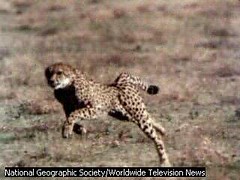
Cheetah Running
The cheetah is believed to be the fastest animal on Earth, reaching speeds of more than 97 km/h (60 mph) while chasing prey. Wildebeests, gazelles, impalas, and other hoofed mammals make up much of the cheetah’s diet. Cheetahs generally stalk their prey to within 10 m (33 ft) and then burst into a sprint to close the gap. Studies indicate that approximately half of the chases initiated by the cheetah are successful.
National Geographic Society/Worldwide Television News

Pigeon in Flight
A bird moves its wings in two ways during flapping flight. The part of the wing closest to the bird’s body moves up and down. Simultaneously, the tip of the wing moves in a circular motion, propelling the bird forward. The way a bird flies depends on the shape of its wings. Most small birds flap their wings the entire time they are airborne, while gulls and other large birds with long, pointed wings soar or glide. The fastest fliers have sharply tapered wings.
Oxford Scientific Films
During the course of evolution, both these kinds of limbs have become modified in many different ways. Aquatic animals often have paddlelike limbs that push against the water, enabling them to speed away from predators or after food, or to maneuver their way around confined spaces. On land, the fastest animals, such as the horse and cheetah, have long legs and a flexible backbone, which helps to increase the length of their stride. Land animals that move by jumping often have highly developed hind legs, with extra-large muscles. In fleas, the muscles squeeze an elastic material called resilin, which flicks the legs back when released. This extremely rapid flick is faster than a jump triggered by muscles alone, and it throws a flea up to 30 cm (12 in) into the air.
Many animals can glide, but only insects, birds, and bats are capable of powered flight. The fastest flying insects are dragonflies, which can reach speeds of about 29 km/h (about 18 mph) in short bursts. However, in terms of speed and endurance, birds are by far the most successful animal aviators. Swans and geese can cruise at 64 km/h (40 mph) for many hours at a time, while peregrine falcons can briefly reach 145 km/h (90 mph) when they swoop down on their prey.
| B | Patterns of Movement |
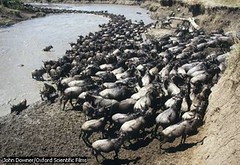
Migrating Wildebeest
The blue wildebeest, or brindled gnu, migrates annually from Kenya to northern South Africa. Along their migratory route the wildebeests stop at watering holes on the Grameti River, where they become the chief source of food for Nile crocodiles. Scientists speculate that the crocodiles of the Grameti River may feed only once a year, when blue wildebeests arrive during their annual migration.
John Downer/Oxford Scientific Films
Being able to move gives animals many advantages, but it also generates its own demands. For any animal, random movement can be unhelpful or even dangerous. To be useful, movement has to be carefully guided.

Monarch Migration
The monarch butterfly, Danaus plexippus, is known for its extraordinarily long migrations. During the summer months, monarchs can be found throughout the continental United States and parts of Canada, and they migrate to the California coast and central Mexico for the winter. The longest recorded flight for a tagged adult is 2,900 km (1,800 mi). A large number of monarchs spend their winters in the mountains west of Mexico City. Scientists speculate that the mountainous climate provides a favorable mix of moist air and cool, but not freezing, temperatures. These conditions keep the butterfly from drying out and keep its metabolism low enough to conserve fat stores but high enough to maintain life.
G. G. Dimijian/Photo Researchers, Inc.
These sensory systems help animals to move toward food and away from possible danger. On a longer time span, they also guide them through much more complex patterns of movement that are essential for their survival. These movements include special kinds of behavior needed to locate a partner, and also seasonal movements or migrations.
Some of the shortest migrations are carried out by microscopic flatworms that live on sandy shores. These worms migrate up to the surface of the sand at low tide and back into it at high tide—a total distance of about 20 cm (about 8 in) roughly twice a day. In the open ocean, many planktonic animals carry out larger daily migrations, rising to the surface at dusk and then sinking at sunrise. By doing this, they reduce the chances of being eaten.
The longest migrations are annual ones, undertaken by animals in response to the changing seasons. By carrying out these journeys, animals can breed in places where food is abundant for just a few months each year. Long-distance annual migration is seen in some plant-eating mammals, such as wildebeest and caribou, and also in whales, but it is most common in animals that fly. Some birds, such as terns and shearwaters, migrate over 32,000 km (20,000 mi) each year. Research has shown that during these epic journeys, they use a variety of cues to help them navigate. These include familiar landmarks, the position of the sun and stars, and the also the orientation of Earth’s magnetic field (see Animal Migration).
| VII | REPRODUCTION |
Like all living things, animals have limited life spans. Although individual animals eventually die, reproduction ensures that they hand on their characteristics to future generations. Animals reproduce at markedly different rates, but all have the potential to increase their numbers if resources allow it. In practice, sharp increases are rare, kept in check by predators and food shortages.
| A | Forms of Reproduction |
Animal reproduction takes two overall forms. In the first form, called asexual reproduction, animals produce offspring without needing a partner. Asexual reproduction is most common in simple animals such as flatworms and cnidarians. In flatworms, the parent often develops a constriction in its body, and the rear part eventually tears itself free. The rear part grows a new head, while the front part grows a new tail. Some cnidarians can also divide in two, but many reproduce by a different process, called budding. During budding, a small outgrowth of the body slowly develops into a complete new animal, which eventually takes up life on its own.
Asexual reproduction also occurs in insects such as aphids and in a few unusual vertebrates, such as whiptail lizards. However, in general, it is rarely used as an animal’s sole method of reproduction. This is because asexual reproduction produces offspring that are genetically identical to their parent. They inherit all their parent’s weak points and are equally vulnerable if a disease or other changes in the environment threaten the group’s survival.
A second and much more common form of reproduction, sexual reproduction, involves two parents. The parents produce sperm and egg cells (gametes), which are brought together to form a fertilized cell (zygote) with a new and unique combination of genes. In this genetic lottery, offspring inherit unique combinations of characteristics that increase the likelihood that at least some individuals in the population can survive changes in the environment.
Sexual reproduction is used by the vast majority of the world’s animals. However, a significant number of species, particularly in the world of insects, use both forms of reproduction at different stages of their life cycles. They reproduce asexually when food is abundant, but turn to sexual reproduction when conditions become more severe.
| B | Reproductive Strategies |
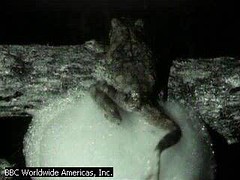
Modes of Frog Reproduction
BBC Worldwide Americas, Inc.
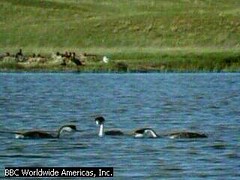
Western Grebe Courtship
During the spring, western grebes perform spectacular courtship dances. In the “rushing” display, the mating pair swim side-by-side with their wings held back, their long necks arched, and their yellow beaks angled upward. They swim so quickly that their bodies are pushed up out of the water and they appear to run across the surface. After courtship the male and female build a floating nest out of plant material.
BBC Worldwide Americas, Inc.
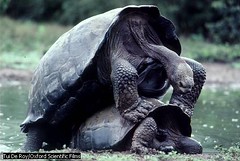
Internal Fertilization
Terrestrial vertebrates clasp each other tightly during copulation, the act by which the male deposits his sperm into the female’s reproductive tract. In the giant Galápagos tortoises pictured here, mating may take hours.
Tui De Roy/Oxford Scientific Films
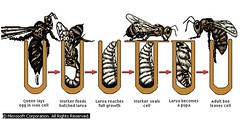
Honey Bee From Egg to Adult
The queen honey bee may lay 1500 eggs in a single day. Worker bees feed the wormlike larva constantly—as many as 1300 times a day—after it hatches, sealing the cell when the grub has grown to fill it. The larva pupates in about 12 days, and the adult bee chews through the wax cap of its cell approximately three weeks after the eggs were first laid. Newly emerged adults perform various maintenance tasks until they are ready to begin foraging outside the hive.
© Microsoft Corporation. All Rights Reserved.
The males of many insects and virtually all mammals use a penis to transfer sperm to the female, who harbors the eggs, in a process known as copulation. The penis ensures that sperm is transferred successfully without being carried away by wind, water, or other environmental elements. Most birds and reptiles mate using a cloaca, a single opening located on the lower abdomen. During mating, these animals align their cloacas for transfer of sperm. Some birds, such as bald eagles, can perform this feat in mid-air.
Once a female has mated, egg development can proceed in two different ways. In oviparous species, which include the majority of vertebrates except mammals, and also most insects, the fertilized eggs are laid and develop outside the mother’s body. In viviparous animals, which include nearly all mammals together with some reptiles and sharks, the young develop inside the mother and are born live.
Most animals that are born live look similar to their parents, although they are not fully developed. By contrast, many egg-laying invertebrates look completely different from their parents when they hatch and often live in a completely different way. Known as larvae, these young change shapes as they grow up, during a process called metamorphosis. Larvae are also found in some fish and most amphibians.
| C | Mating Systems |
Animals that reproduce sexually have evolved a wide variety of different systems for maximizing the number of young that can be raised. In the simplest system, each female is partnered by a male, and the partnership lasts for life. In more complex systems, the fittest adults have many partners while others have none at all.
In polygynous breeding systems, successful males mate with more than one female. Polygyny is common in birds, particularly in species where the males establish breeding territories that provide access to food. A male with a good territory may attract several mates, while one with an inferior territory may attract few or none. Polygyny can also be seen in some mammals and is taken to extremes in species such as elephant seals. The largest and most powerful male elephant seals, weighing up to four times as much as the females, clash viciously for dominance on a breeding beach. A successful male can assemble a harem of over twenty females, but weaker males are excluded from breeding altogether.
In polyandrous breeding systems, one female mates with several males. This kind of breeding system is rare and usually occurs in species where the males take on the work of raising the young. An example of a polyandrous bird is the North American spotted sandpiper. In this species, females compete for males. A single female can lay up to five sets, or clutches, of eggs, and each clutch is incubated by a different partner.
The most specialized mating systems of all occur in animals that form permanent family groups. In social insects, which include many bees and wasps and all ants and termites, each group or colony is founded by a single female or queen. The queen is the only individual in the colony to reproduce. Her offspring, which can number more than a million, forage for food, maintain the nest, and care for the young.
| D | Parental Care |

Killer Whale Family
Showing the characteristic contrasting white patches above the eyes and under the jaws, a male and female killer whale, Orcinus orca, swim protectively on either side of their baby. Killer whales maintain close ties to the social structure of their natal pods, or groups, for life. To prevent inbreeding, however, the whales typically seek mates outside of their original pod.
David E Myers/Tony Stone Images
With the exception of birds, the majority of egg-laying animals play no part in helping their young to survive. A large proportion of their young die, and to offset this, they often produce a huge number of eggs. A housefly, for example, can lay over a thousand eggs in the course of its life, while a female cod can lay 3 million.
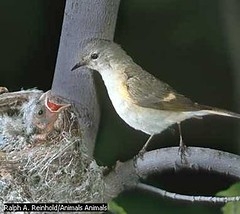
American Redstart Feeding Young
A female American redstart turns toward her offspring, which begs for food with its gaping mouth.
Ralph A. Reinhold/Animals Animals
Parental care is equally important in mammals, which provide food for their young in the form of milk. Raising a family in this way creates a close link between the mother and her young. This method also allows the young to learn important patterns of behavior by watching their mother at work. In small rodents, this learning period lasts for just a few days, but in larger mammals, it can last for more than a year.
| VIII | STRATEGIES FOR SURVIVAL |
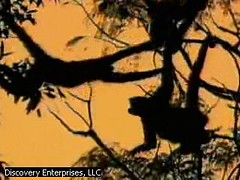
Animals in Extremes
Discovery Enterprises, LLC
In the living world, resources such as food and space are limited. As a result, survival is a constant struggle. Through evolution, animals have developed a range of adaptations that give them the best chances of success.
The most obvious of these adaptations are physical ones that affect the shape or structure of an animal’s body. Equally important, although often less conspicuous, are adaptations that affect behavior and body processes. Together, these different adaptations allow each species to pursue a distinctive way of life.
| A | Physical Adaptations |
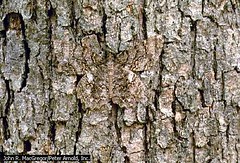
Tulip-Tree Beauty
The tulip-tree beauty is a large moth that feeds on the foliage of the tulip tree as a caterpillar. Found from southern Canada to Florida, the moths often have banded coloration that camouflages them against tree bark.
John R. MacGregor/Peter Arnold, Inc.
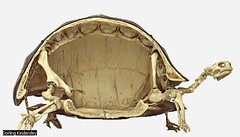
Turtle Skeleton
The turtle or tortoise body is encased in a shell made up of a series of bony plates covered with a horny shield. The vertebrae and ribs are fused to the inside of this shell, which gives it additional support and strength. It is impossible for turtles or tortoises to crawl out of their shells. Turtles have a relatively flattened shell and are aquatic, while tortoises have a dome-shaped shell and are terrestrial.
Dorling Kindersley

Regal Horned Lizard
The well-camouflaged regal horned lizard, Phrynosoma solare, requires so many ants a day to sustain it that it almost always is found near an anthill. Regal horned lizards usually fare poorly in captivity, where quantities of ants are often insufficient. It remains motionless if approached, but if picked up, it may attempt to disconcert its attacker by puffing up its body and squirting blood, sometimes as far as a few feet, from a reserve behind its eyes. The regal horned lizard is the largest of the American species of horned lizards and can be recognized by the four large horns on the back of its head.
M.P.L. Fogden/Oxford Scientific Films
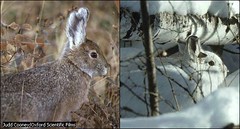
Snowshoe Hare in Summer and Winter
The snowshoe hare uses camouflage to hide from predators. The summer coat of the snowshoe hare provides excellent camouflage among the grasses and shrubs of its summer habitat, while the white winter coat blends in perfectly with the snowy forest.
Judd Cooney/Oxford Scientific Films
An alternative defense, seen in a wide range of animals, uses armor or spines to fend off an attack. Animal armor includes hard shells, overlapping scales, and in the case of armadillos, bands of hardened plates connected by areas of softer skin. If they are threatened, many of these animals can shut their bodies away inside their armor, making them difficult to attack. The disadvantage of this defense is that the animal cannot escape. If its armor is broken open, death is almost certain.
| B | Behavioral Adaptations |
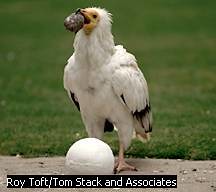
Egyptian Vulture
This Egyptian vulture holds a stone in its beak in preparation for smashing an ostrich egg. Egyptian vultures are unusual among birds because they use stones as tools for obtaining food.
Roy Toft/Tom Stack and Associates
In simple animals, behavior is governed almost entirely by instinct, meaning that it is pre-programmed by an animal’s genes. In more complex animals, instinctive behavior is often modified by learning, producing more-flexible responses to the outside world.
Many forms of behavior help animals to survive severe environmental conditions. Two examples are hibernation, which enables animals to survive cold and food shortages in winter; and estivation, which allows animals to survive drought and heat in summer. True hibernators, such as bats and some rodents, become completely inactive during winter, and their body temperature falls close to freezing. While in this state, they survive entirely on food reserves stored in their bodies. Estivating animals, which include land snails and some amphibians, seal themselves up when conditions become dry and only become active again when it rains. Between these two extremes, many other animals show less drastic patterns of behavior that are triggered by cold or heat. Winter wrens, for example, often crowd together for sleep when temperatures fall below freezing. On warmer nights, they sleep on their own.
Special forms of behavior also help animals to find food, to avoid being eaten, and to protect their young. One of the most advanced forms of this behavior is the use of tools. Several kinds of animals, particularly primates and birds, pick up implements such as twigs and stones and use them to get at food. More rarely, some tool-using animals seek out a particular object and then shape it so that it can be used. Woodpecker finches probe for insect grubs by making tools from cactus spines, and chimpanzees sometimes dig for termites using specially prepared twigs.
Defensive behavior is exhibited by individual animals and also by animal groups. Group defense is common in herding mammals, particularly in species such as the musk-ox, which form a protective ring around their calves when threatened by wolves. It can also be seen in swallows, starlings, and other songbirds, which instinctively mob hawks and other birds of prey. By grouping together to harass their enemies, they reduce the chances that they or their young will be singled out and attacked.
Individual defensive behavior is often based on threatening gestures that make an animal look larger or more dangerous than it actually is. Sometimes it involves some highly specialized forms of deception. One of the most remarkable is playing dead. Seen in animals such as the Virginia opossum and some snakes, this last-ditch defense is effective against predators that habitually hunt moving prey but leave dead animals alone. After the predator has inspected the “dead” animal and moved on, the prey comes back to life and makes its escape.
| IX | ORIGINS OF ANIMALS |

Purple and Yellow Tube Sponge
The purple and yellow tube sponge displays one of the many different body forms typical of sponges. Sponges, considered to be the most primitive of the multicellular animals, are represented in the fossil record back to the Cambrian Period, at least 600 million years ago. The interior body cavities of sponges provide shelter for a variety of small crabs, sea stars, and other marine invertebrates.
Joe Dorsey/Oxford Scientific Films
Most biologists agree that animals evolved from simpler single-celled organisms. Exactly how this happened is unclear, because few fossils have been left to record the sequence of events. Faced with this lack of fossil evidence, researchers have attempted to piece together animal origins by examining the single-celled organisms alive today.
Modern single-celled organisms are classified into two kingdoms: the prokaryotes and protists. Prokaryotes, which include bacteria, are very simple organisms, and lack many of the features seen in animal cells. Protists, on the other hand, are more complex, and their cells contain all the specialized structures, or organelles, found in the cells of animals. One protist group, the choanoflagellates or collar flagellates, contains organisms that bear a striking resemblance to cells that are found in sponges. Most choanoflagellates live on their own, but significantly, some form permanent groups or colonies.
This tendency to form colonies is widely believed to have been an important stepping stone on the path to animal life. The next step in evolution would have involved a transition from colonies of independent cells to colonies containing specialized cells that were dependent on each other for survival. Once this development had occurred, such colonies would have effectively become single organisms. Increasing specialization among groups of cells could then have created tissues, triggering the long and complex evolution of animal bodies.
This conjectural sequence of events probably occurred along several parallel paths. One path led to the sponges, which retain a collection of primitive features that sets them apart from all animals. Another path led to two major subdivisions of the animal kingdom: the protostomes, which include arthropods, annelid worms, mollusks, and cnidarians; and the deuterostomes, which include echinoderms and chordates. Protostomes and deuterostomes differ fundamentally in the way they develop as embryos, strongly suggesting that they split from each other a long time ago.
Animal life first appeared perhaps a billion years ago, but for a long time after this, the fossil record remains almost blank. Fossils exist that seem to show burrows and other indirect evidence for animal life, but the first direct evidence of animals themselves appears about 650 million years ago, toward the end of the Precambrian period. At this time, the animal kingdom stood on the threshold of a great explosion in diversity (see Biodiversity). By the end of the Cambrian Period, 150 million years later, all of the main types of animal life existing today had become established.
| A | Moving onto Land |
When the first animals evolved, dry land was probably devoid of any kind of life, except possibly bacteria. Without terrestrial plants, land-based animals would have had nothing to eat. But when plants took up life on land over 400 million years ago, that situation changed, and animals evolved that could make use of this new source of food. The first land animals included primitive wingless insects and probably a range of soft-bodied invertebrates that have not left fossil remains. The first vertebrates to move onto land were the amphibians, which appeared about 370 million years ago.
For all animals, life on land involved meeting some major challenges. Foremost among these were the need to conserve water and the need to extract oxygen from the air. Another problem concerned the effects of gravity. Water buoys up living things, but air, which is 750 times less dense than water, generates almost no buoyancy at all. To function effectively on land, animals needed support.
In soft-bodied land animals such as earthworms, this support is provided by a hydrostatic skeleton, which works by internal pressure. The animal’s body fluids press out against its skin, giving the animal its shape. In insects and other arthropods, support is provided by the exoskeleton (external skeleton), while in vertebrates it is provided by bones. Exoskeletons can play a double role by helping animals to conserve water, but they have one important disadvantage: unlike an internal bony skeleton, their weight increases very rapidly as they get bigger, eventually making them too heavy to move. This explains why insects have all remained relatively small, while some vertebrates have reached very large sizes.
| B | Speciation and Extinction |
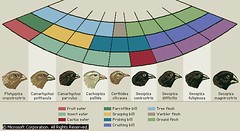
Galápagos Finches
The fourteen species of finch that inhabit the Galápagos Islands are believed to have evolved from a single species resembling the blue-black grassquit, Volatinia jacarina, abundant in Latin America and the Pacific coast of South America. The ancestral finch, with its short, stout, conical bill specialized for crushing seeds, probably migrated from the mainland to the Galápagos Islands. Its descendants, free to exploit the resources they would otherwise share with warblers, woodpeckers, and other birds, adapted to the available range of habitats (tree, cactus, or ground) and food (seeds, cactus, fruit, or insects). The size and shape of their bills reflect these specializations, an example of adaptive radiation.
© Microsoft Corporation. All Rights Reserved.
Like other living things, animals evolve by adapting to and exploiting their surroundings. In the billion-year history of animal life, this process has created vast numbers of new species, each capable of using resources in a slightly different way. Some of these species are alive today, but these are a minority; an even greater number are extinct, having lost the struggle for survival.
Speciation, the birth of new species, usually occurs when a group of living things becomes isolated from others of their kind (see Species and Speciation). Once this has occurred, the members of the group follow their own evolutionary path and adapt in ways that make them increasingly distinct. After a long period—typically thousands of years—their unique features mean that they can no longer breed with their former relatives. At this point, a new species comes into being.
In animals, this isolation can come about in several different ways. The simplest form, geographical isolation, occurs when members of an original species become separated by a physical barrier. One example of such a barrier is the open sea, which isolates animals that have been accidentally stranded on remote islands. As the new arrivals adapt to their adopted home, they become more and more distinct from their mainland relatives. Sometimes the result is a burst of adaptive radiation, which produces a number of different species. In the Hawaiian Islands, for example, 22 species of honeycreepers have evolved from a single pioneering species of finch-like bird.
Another type of isolation is thought to occur where there is no physical separation. In this case, differences in behavior, such as mate selection, may sometimes help to split a single species into distinct groups. If the differences persist for a long enough time, new species are created.
The fate of a new species depends very much on the environment in which it evolved. If the environment is stable and no new competitors appear on the scene, an animal species may change very little in hundreds of thousands of years. But if the environment changes rapidly and competitors arrive from outside, the struggle for survival is much more intense. In these conditions, either a species changes, or it eventually becomes extinct.
During the history of animal life, on at least five occasions, sudden environmental change has triggered simultaneous extinction on a massive scale. One of these mass extinctions occurred at the end of the Cretaceous Period, about 65 million years ago, killing all dinosaurs and perhaps two-thirds of marine species. An even greater mass extinction took place at the end of the Permian Period, about 200 million years ago. Many biologists believe that we are at present living in a sixth period of mass extinction, this time triggered by human beings.
| X | ANIMALS IN THE BALANCE OF NATURE |
Compared to plants, animals make up only a small part of the total mass of living matter on earth. Despite this, they play an important part in shaping and maintaining natural environments.
Many habitats are directly influenced by the way animals live. Grasslands, for example, exist partly because grasses and grazing animals have evolved a close partnership, which prevents other plants from taking hold. Tropical forests also owe their existence to animals, because most of their trees rely on animals to distribute their pollen and seeds. Soil is partly the result of animal activity, because earthworms and other invertebrates help to break down dead remains and recycle the nutrients that they contain. Without its animal life, the soil would soon become compacted and infertile.
By preying on each other, animals also help to keep their own numbers in check. This prevents abrupt population peaks and crashes and helps to give living systems a built-in stability. On a global scale, animals also influence some of the nutrient cycles on which almost all life depends. They distribute essential mineral elements in their waste, and they help to replenish the atmosphere’s carbon dioxide when they breathe. This carbon dioxide is then used by plants as they grow.
| A | Animals and People |
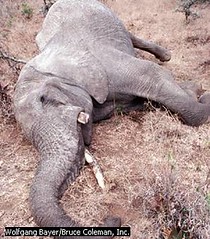
African Elephant Killed by Poachers
Elephant populations are on the brink of extinction due to poachers who kill elephants for their ivory tusks. An international ban on ivory trade, instituted in 1989 by the Convention on International Trade in Endangered Species of Wild Fauna and Flora (CITES), has diminished the illicit ivory trade and reduced the killing. Over 120 countries support the ban.
Wolfgang Bayer/Bruce Coleman, Inc.
Until relatively recently in human history, people existed as nomadic hunter-gatherers. They used animals primarily as a source of food and also for raw materials that could be used for making tools and clothes. By today’s standards, hunter-gatherers were equipped with rudimentary weapons, but they still had a major impact on the numbers of some species. Many scientists believe, for example, that humans were involved in a cluster of extinctions that occurred about 12,000 years ago in North America. In less than a millennium, two-thirds of the continent’s large mammal species disappeared.
This simple relationship between people and animals changed with domestication, which also began about 12,000 years ago. Instead of being actively hunted, domesticated animals were slowly brought under human control. Some were kept for food or for clothing, others for muscle power, and some simply for companionship.
The first animal to be domesticated was almost certainly the dog, which was bred from wolves. It was followed by species such as the cat, horse, camel, llama, and aurochs (a species of wild cattle), and also by the Asian jungle fowl, which is the ancestor of today’s chickens. Through selective breeding, each of these animals has been turned into forms that are particularly suitable for human use. Today, many domesticated animals, including chickens, vastly outnumber their wild counterparts. In some cases, such as the horse, the original wild species has died out altogether.
Over the centuries, many domesticated animals have been introduced into different parts of the world only to escape and establish themselves in the wild. Together with stowaway pests such as rats, these feral animals have often had a highly damaging effect on native wildlife. Cats, for example, have inflicted great damage on Australia’s smaller marsupials, and feral pigs and goats continue to be serious problems for the native wildlife of the Galápagos Islands.
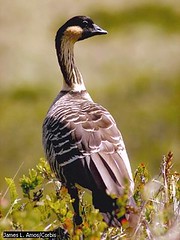
Endangered Nēnē Goose
Rats and mongooses introduced in the Hawaiian Islands have found an easy meal in the nēnē goose, one of the many bird species native only to Hawaii. Through captive breeding programs, the population of this endangered bird had rebounded to more than 1,000 by the early 2000s, but today the birds are all genetically similar, creating inbreeding that harms their chances of survival.
James L. Amos/Corbis
Since the beginning of agriculture, the human population has increased by more than two thousand times. To provide the land needed for growing food and housing people, large areas of Earth’s landscapes have been completely transformed. Forests have been cut down, wetlands drained, and deserts irrigated, reducing these natural habitats to a fraction of their former extent.
Some species of animals have managed to adapt to these changes. A few, such as the brown rat, raccoon, and house sparrow, have benefited by exploiting the new opportunities that have opened up and have successfully taken up life on farms, or in towns and cities. But most animals have specialized ways of life that make them dependent on a particular kind of habitat. With the destruction of their habitats, their number inevitably declines.
During the last century or so, animals have also had to face additional threats from human activities. Foremost among these are environmental pollution and the increasing demand for resources, such as timber and fresh water. For some animals, the combination of these changes has proved so damaging that their numbers are now below the level needed to guarantee survival.
Across the world, efforts are currently under way to address this urgent problem (see Endangered Species). In the most extreme cases, gravely threatened animals can be helped by taking them into captivity and then releasing them once breeding programs have increased their number. One species that was restored in this way is the Hawaiian mountain goose or nēnē. In the 1950s, its population had been reduced to about 25 birds. Captive breeding has since helped the population increase, although the nēnē remains on the endangered list.
While captive breeding is a useful emergency measure, it cannot assure the long-term survival of a species. Today animal protection focuses primarily on the preservation of entire habitats, an approach that maintains the necessary links between the different species the habitats support. With the continued growth in the world’s human population, habitat preservation will require a sustained reduction in our use of the world’s resources to minimize our impact on the natural world.
Contributed By:
David Burnie
Microsoft ® Encarta ® 2007. © 1993-2006 Microsoft Corporation. All rights reserved.

Comments
Post a Comment
Bagi Yang Mau Memberi Komentar Tinggal Poskan Komentar di Kotak Komentar..
Yang tak punya url bisa dikosongkan..
tapi tolong di diisi oke Name-nya
Komentar anda saya tunggu :d